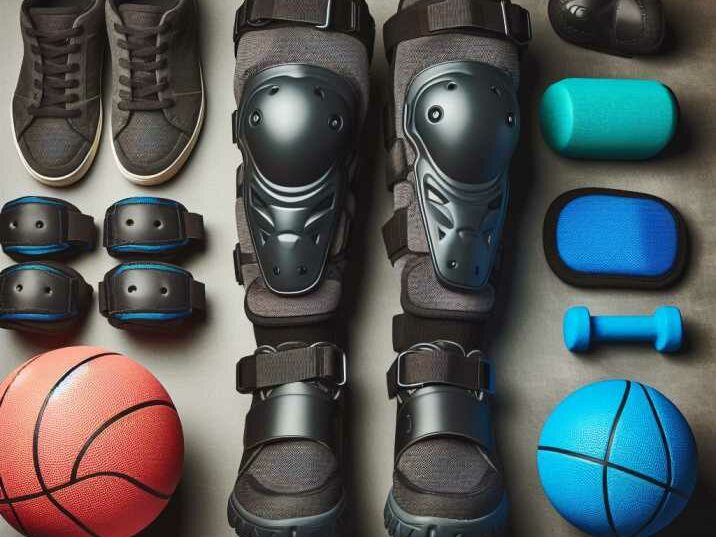Introduction:
Table of Contents
Dodgeball is a dynamic and exciting game enjoyed by many, but it’s crucial to prioritize safety while playing. This article will delve into eight essential safety tips every dodgeball player should be aware of and implement. By following these guidelines and safety tips, players can minimize the risk of injuries and ensure a fun and enjoyable experience on the court.

Dodgeball Safety Tips:
By adhering to these safety tips, players can significantly reduce the likelihood of sustaining injuries during dodgeball matches. Here are some safety tips:
1. Proper Warm-Up and Stretching:
Before engaging in any physical activity, including dodgeball, it’s essential to prepare your body adequately. Begin with a light warm-up such as jogging or jumping jacks to increase heart rate and blood flow. Following this, dedicate time to stretching major muscle groups such as the arms, legs, and shoulders. Stretching helps improve flexibility and reduces the risk of strains and sprains during gameplay.
Importance of Warm-Up:
A proper warm-up primes the body for physical exertion by increasing muscle temperature and flexibility. It prepares players mentally and physically for the demands of dodgeball, enhancing performance and reducing the likelihood of injury.
Effective Stretching Techniques:
Effective stretching involves targeting specific muscle groups used in dodgeball through a combination of static and dynamic stretches. Focus on stretches that elongate the arms, legs, and torso, holding each stretch for 15-30 seconds without bouncing to prevent injury.
2. Wear Appropriate Gear:
The right gear can significantly enhance safety and performance on the dodgeball court. Players should opt for comfortable athletic clothing that allows for freedom of movement. Additionally, consider wearing knee pads and elbow pads to protect joints from impact injuries. Proper footwear with good traction is essential to prevent slips and falls, especially on hard court surfaces.
Choosing the Right Clothing:
Select breathable, moisture-wicking fabrics that provide comfort and mobility during gameplay. Avoid clothing with loose or dangling components that may become entangled or cause distractions while playing.
Importance of Protective Gear:
Knee pads and elbow pads offer vital protection against impacts and abrasions during dodgeball. Investing in quality protective gear can mitigate the risk of bruises, scrapes, and more severe injuries, providing players with added confidence and safety on the court.

3. Know the Rules of the Game:
Understanding the rules and regulations of dodgeball is essential for safe and fair gameplay. Familiarize yourself with court boundaries, player interactions, and penalty rules to avoid infractions and potential collisions. Clear communication and adherence to the rules contribute to a positive and enjoyable experience for all participants.
Familiarizing Yourself with Court Boundaries:
Knowing the boundaries of the dodgeball court helps prevent accidental out-of-bounds plays and collisions with surrounding obstacles. Stay within the designated playing area to avoid penalties and maintain game flow.
Understanding Player Interactions:
Learn the rules governing player interactions, such as throwing, catching, and dodging. Understanding these interactions promotes fair play and reduces the risk of aggressive or unsafe behavior on the court.
4. Communicate with Your Teammates:
Effective communication among teammates is paramount in dodgeball, promoting teamwork and injury prevention. Maintain open lines of communication to coordinate movements, strategies, and defensive maneuvers. Vocalize your position and intentions to avoid collisions and maximize gameplay efficiency.
Coordination Strategies:
Develop coordinated strategies with your teammates to outmaneuver opponents and maintain control of the game. Assign roles and responsibilities based on each player’s strengths and position on the court, fostering synergy and cohesion within the team.
Alerting Teammates to Incoming Balls:
Warn your teammates of incoming balls to facilitate timely evasive actions or defensive maneuvers. Clear and concise communication enhances situational awareness and minimizes the risk of accidental collisions or missed opportunities.
5. Keep an Eye on the Ball:
Maintaining visual focus on the dodgeball is essential for anticipation and reaction during gameplay. Track the trajectory of incoming balls and adjust your position accordingly to evade or intercept them effectively. Peripheral awareness of surrounding players and obstacles enhances overall situational awareness on the court.
Anticipating Ball Movement:
Develop anticipation skills to predict the path of incoming balls based on the thrower’s positioning, trajectory, and velocity. Anticipatory movements enable players to react swiftly and strategically, increasing their chances of avoiding impacts or executing successful catches.
Utilizing Peripheral Vision:
Expand your awareness beyond the immediate vicinity of the ball to include peripheral vision of surrounding players and court boundaries. Peripheral awareness helps players assess potential threats and opportunities, allowing for proactive decision-making and risk mitigation.
6. Avoid Headshots:
Head injuries pose significant risks in dodgeball, emphasizing the importance of protecting this vulnerable area. Employ defensive strategies such as head movement and arm shielding to minimize the likelihood of direct headshots. Aim for opponents’ bodies rather than their heads when throwing the ball, prioritizing safety and sportsmanship in gameplay.
Defensive Head Movements:
Incorporate head movements such as ducking, swaying, or tilting to evade incoming balls and reduce the likelihood of headshots. Dynamic head positioning enhances agility and reduces the target area exposed to opponents, mitigating the risk of injury.
Protective Arm Shielding:
Use your arms as a shield to protect your head and face from incoming balls, positioning them in front of your upper body as a defensive barrier. Maintain awareness of your arm placement relative to your head to ensure effective protection without impeding visibility or mobility.
7. Take Breaks When Needed:
Listening to your body’s signals is crucial for preventing fatigue and overexertion during dodgeball gameplay. Take periodic breaks to rest, hydrate, and assess your physical condition, especially during extended or intense matches. Prioritize self-care and pacing to sustain performance and reduce the risk of injuries associated with fatigue.
Recognizing Signs of Fatigue:
Be mindful of physical and mental signs of fatigue, such as muscle soreness, decreased coordination, and diminished concentration. Acknowledge these signals as indicators to take breaks and replenish energy levels, safeguarding against exhaustion and potential injury.
Implementing Rest and Recovery Strategies:
Incorporate rest and recovery strategies such as hydration, nutrition, and stretching during breaks to optimize physical and mental well-being. Hydrate with water or electrolyte-rich beverages, refuel with nutritious snacks, and perform gentle stretches to alleviate muscle tension and promote circulation.
8. Stay Hydrated:
Proper hydration is essential for sustaining performance and minimizing the risk of dehydration-related complications during dodgeball gameplay. Drink water regularly before, during, and after matches to replenish fluids lost through perspiration and maintain optimal hydration levels. Avoid sugary or caffeinated beverages that may contribute to dehydration or gastrointestinal discomfort.
Hydration Strategies:
Establish a hydration routine that includes pre-game, intra-game, and post-game hydration practices to support endurance and recovery. Consume water at regular intervals, aiming for sufficient fluid intake to offset sweat losses and maintain electrolyte balance throughout gameplay.
Hydration Monitoring:
Monitor your hydration status by assessing urine color, thirst sensation, and overall fluid intake relative to sweat output. Pale yellow urine and minimal thirst indicate adequate hydration, while dark-colored urine and persistent thirst may signify dehydration requiring prompt rehydration measures.
Table of Information Safety Tips:
| Safety Tips | Description |
|---|---|
| Proper Warm-Up | Increase blood flow and flexibility through light cardio and stretching exercises. |
| Appropriate Gear | Wear comfortable athletic clothing, knee pads, elbow pads, and supportive footwear. |
| Know the Rules | Familiarize yourself with the rules of the game and court boundaries. |
| Communicate with Teammates | Coordinate movements and strategies with teammates to avoid collisions. |
| Keep an Eye on the Ball | Stay aware of incoming balls and anticipate their trajectory to avoid being hit. |
| Avoid Headshots | Protect your head and aim for opponents’ bodies rather than their heads. |
| Take Breaks | Listen to your body and take breaks when needed to prevent overexertion. |
| Stay Hydrated | Drink plenty of water to stay hydrated and maintain energy levels throughout the game. |
Conclusion:
In conclusion, prioritizing safety tips is paramount for an enjoyable and injury-free dodgeball experience. By implementing proper warm-up and stretching routines, wearing appropriate gear, understanding the rules of the game, communicating effectively with teammates, and practicing vigilant ball awareness, players can minimize the risk of injuries such as strains, sprains, and headshots. Additionally, taking breaks when needed and staying hydrated are essential for sustaining performance and promoting overall well-being on the court. By following these eight safety tips, dodgeball enthusiasts can play confidently and responsibly, fostering a culture of sportsmanship and enjoyment in the game.
FAQs:
Q1: Can dodgeball be dangerous?
A1: While dodgeball can be a fun and exhilarating game, it does come with some risks of injury, particularly if players aren’t careful. However, by following proper safety guidelines and wearing the right gear, you can minimize these risks significantly.
Q2: What should I wear to play dodgeball?
A2: It’s best to wear comfortable athletic clothing that allows for ease of movement, along with supportive athletic shoes. Consider wearing knee pads and elbow pads for added protection, especially if you’re playing on a hard court surface.
Q3: How can I avoid getting hit by the ball?
A3: Keeping your eyes on the ball at all times and staying aware of your surroundings is key to avoiding getting hit. Practice agility and dodging movements to evade incoming balls, and use teamwork to strategize and protect each other on the court.
Q4: Are there age restrictions for playing dodgeball?
A4: While dodgeball can be enjoyed by people of all ages, it’s essential to consider the physical abilities and limitations of players, particularly in more competitive settings. Some leagues or tournaments may have age restrictions or guidelines for participation.
Q5: What should I do if I get injured while playing dodgeball?
A5: If you sustain an injury while playing dodgeball, it’s important to stop playing immediately and assess the severity of the injury. Seek medical attention if needed, and allow yourself time to rest and recover before returning to the game. It’s always better to prioritize your health and safety over continuing to play through pain or discomfort.


